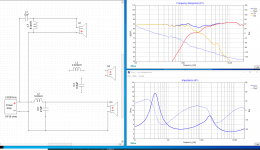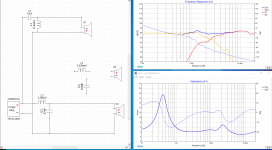Looks like a reasonable start.
Some points to take into account:
Some points to take into account:
- Will you be sitting off-axis? High frequency response is rising on the graph (on-axis?), which will sound bright unless you sit off-axis.
- Around the crossover frequency, the summed power could be 3dB higher.
- A crossover frequency of 2 kHz is too low for a Seas H1396-04 tweeter, unless you do not listen at high SPL. Seas recommends 2.5 kHz on the website.
- The response of the tweeter is a bit weird. It shelves down before the high pass kicks in. Maybe a third order electrical high pass can solve this.
- Did you include baffle step?
- Did you include the acoustical offset between woofer and tweeter? The woofer is further back, which affects the phase.
Last edited:
Looks like a reasonable start.
Some points to take into account:
- Will you be sitting off-axis? High frequency response is rising on the graph (on-axis?), which will sound bright. Off-axis it might be better.
- Around the crossover frequency, the summed power could be 3dB higher.
- A crossover frequency of 2 kHz is too low for a Seas H1396-04 tweeter, unless you do not listen at high SPL. Seas recommends 2.5 kHz on the website.
- Did you include baffle step?
- Did you include the acoustical offset between woofer and tweeter? The woofer is further back, which affects the phase.
On-axis and off-axis? i am a amateur 😀😀😀
I lowered the value to 0,56 on the inductor on the 6",now it has a 2,5khz xo point !
No have only simulated the crossover,no bafflestep etc etc.
Attachments
@JKTHN - to figure out BSC in Xsim it's easy. In the upper right window, show the woofer raw frequency response, and the frequency response with your LP filter. Adjust the seried inductor value up and down until you see about a 3 dB difference in the curves. That gives you the desired 3dB BSC. Then you adjust the capacitor to ground for the rolloff you need to crossover to the tweeter.


